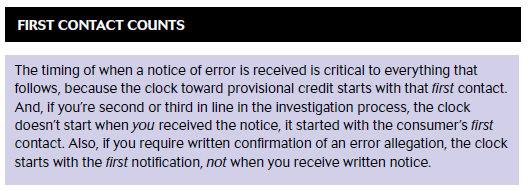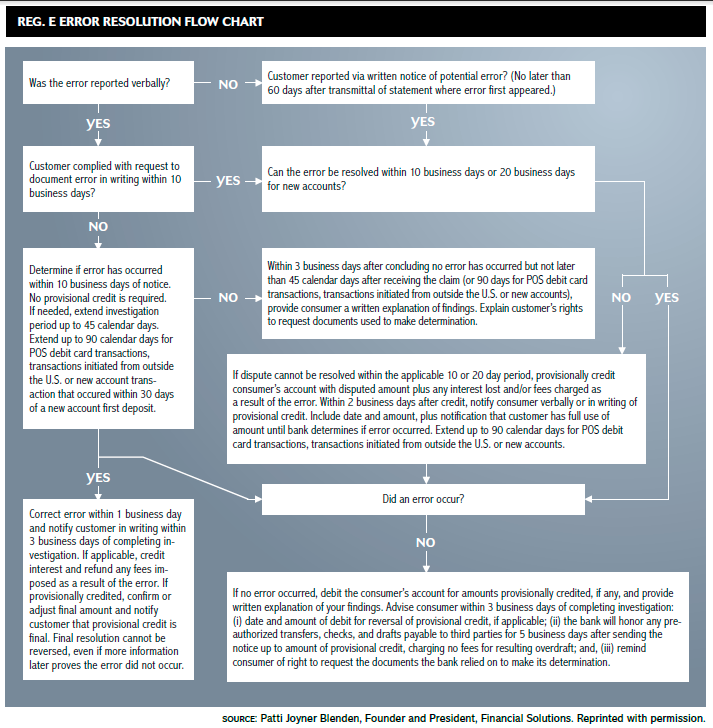CFPB Field Hearing: Reg. E Error Resolution Is Everyone’s Business
 Editor’s Note: Paybefore is rerunning this article because we believe Reg E could play a prominent role in the CFPB’s Notice of Proposed Rulemaking for GPR cards, which is expected to be released this week.
Editor’s Note: Paybefore is rerunning this article because we believe Reg E could play a prominent role in the CFPB’s Notice of Proposed Rulemaking for GPR cards, which is expected to be released this week.
By Marilyn Bochicchio, CEO
Regulation E, implementing the 1978 Electronic Fund Transfer Act, was created largely to protect consumers who used what were then newfangled ATMs or recurring ACH payments. Nearly 40 years later, the CFPB is using Reg. E to address new forms of electronic payment, while sending clear signals that it’s intent on enforcement— and error resolution compliance is squarely in the enforcement crosshairs. In prepaid’s complex value chain, Reg. E error resolution compliance often is a shared responsibility, with third-party service providers (TPSPs) playing a critical role. 1, 2
Provisional Credit
We all know the critical issue with Reg. E error resolution: It’s the provisional credit. In general, the regulation requires financial institutions to investigate and resolve, within 10 business days,3 a consumer (not business) allegation of an error that decreases the value of the consumer’s “consumer asset” account.4 If the error isn’t resolved within the required time, which is often challenging or even impossible, the disputed amount must be credited to the consumer’s account,5 and he must be notified of the availability of the funds within two business days of the credit. And, there can’t be any restrictions on access to the credited funds.
If the financial institution later determines the error didn’t occur or there was a different error, it may debit the provisionally credited amount from the consumer’s account, but it must provide specific notification to the consumer and honor debits to the account for five business days after notification. (Some issuers minimize potential issues by providing notice five days in advance of reversing the provisional credit.) But, if the consumer has spent the money or closed the account, the financial institution may be left holding the bag. The problem of closed or emptied accounts appears to be more significant with prepaid cards because the relationship between the cardholder and financial institution is often thinner or less sticky than, say, a DDA relationship. And, most of the time, there aren’t any other accounts to offset the missing funds in the closed or emptied prepaid account.
The best solution to the challenge of provisional credit is resolving as many alleged errors as possible within the required time frame, so provisional credit doesn’t kick in. Easier said than done, of course. But, the key for all parties— particularly TPSPs—is to understand the rules of the Reg. E error resolution road, fulfill their responsibilities to a T, and work quickly and accurately. There’s no room for sloppiness. Here are five discussion topics that may be useful as you review or conceive your comprehensive Reg. E compliance program in support of your financial institution prepaid issuer:
1. Reg. E Is a Consumer Protection Regulation
The purpose of Reg. E is to protect consumers—not financial institutions or other businesses in the prepaid value chain. It doesn’t matter if consumer negligence (like writing a PIN on the back of a card) contributed to the unauthorized use: All Reg. E error resolution requirements apply. Even if the cardholder mentions that a friend or family member made the unauthorized transaction, it’s still a Reg. E error (provided the consumer doesn’t benefit from the “unauthorized” transaction).
If you understand the underlying intent of Reg. E, a lot of the error resolution requirements become more understandable, although not necessarily easier to comply with.
2. What’s a Reg. E Error and What’s Not
Not every interaction with a consumer triggers Reg. E error resolution procedures. For example, if a consumer makes a routine balance inquiry request, asks for information for tax or recordkeeping purposes, or requests duplicate copies of documentation, a Reg. E error isn’t triggered. But, make sure you understand what the consumer is saying or asking, and never, ever try to “talk a consumer down” from alleging a Reg. E error (“If you think your son made that transaction, you’d better talk to him before you talk to us.”) or put up barriers to alleging an error (“We can’t start our investigation until we get a police report.”).6 If the consumer alleges an error, you are required to accept that allegation at face value in terms of starting an investigation. Period.
But, recognize that not every prepaid card is actually covered by Reg. E. Currently, Reg. E error resolution requirements apply to a subset of prepaid cards: payroll cards, cards that are eligible to receive federal benefits,7 federal tax refunds, government wages or wages from a company with government ownership.8 (Note: Some state-administered prepaid cards follow federal requirements.)
The problem, of course, is differentiating between prepaid cards to determine if they’re subject to Reg. E error resolution procedures. It’s often hard for TPSPs to make this determination, although the issuing financial institution is better positioned because it can access BIN tables. But, even the issuing financial institution is challenged to identify all federal payments. This difficulty has led some prepaid issuers to treat all error resolution allegations as falling under Reg. E, even if technically they don’t.9 As a TPSP you must understand your prepaid issuer’s policies on how it handles errors that technically aren’t covered by Reg. E.
There are other unusual and sticky situations you may run across, such as how to handle a bill pay transaction initiated electronically but paid via paper check. How to handle every oddity that arises is beyond the scope of this article, but the example highlights that employees handling consumer complaints or error allegations involving prepaid (and other forms of electronic transactions) must be great listeners and understand the nuances of what consumers are telling them. If employees are suspicious that a situation may be triggering a Reg. E error, they must escalate the inquiry to someone qualified to make a determination.
By the way, in the above example, a bill pay transaction initiated electronically but paid via paper check generally isn’t covered by Reg. E.
But, what happens if an error allegation doesn’t fall under Reg. E? The financial institution still has an obligation to resolve the problem promptly and communicate with the consumer in accordance with the process outlined in the cardholder agreement. Although provisional credit may not apply, the payments networks’ chargeback obligations may.
Compliant Reg. E error resolution is technical in the sense that time frames for certain actions are specific. There’s no wiggle room. For example, the 10 business-day period to resolve an alleged error starts when the consumer first notifies the party identified in the cardholder agreement. If the consumer notifies you of an error at 11:59 PM on Monday, Nov. 3, the notice of error is considered received on Monday (“Day Zero”), and the 10th business day is Nov. 18. (See chart at right.) It doesn’t matter that you received the notification outside of business hours, if you’re accepting notifications electronically or you have 24-hour customer service, “business hours” aren’t relevant to when the error resolution clock starts ticking. Similarly, if you’ve asked for written confirmation of an error, the consumer has until midnight (not your close of business) on the 10th business day to provide that confirmation.
Other critical time requirements:
- The consumer must be notified of the provisional credit (including the posting date and amount) within two business days of the credit to his prepaid account.
- If, after the investigation, you determine the consumer is not owed the provisional credit, before you can debit the provisional credit, he must be notified that debits to the account will be honored for five business days following the notice. (Alternatively, you may notify the consumer five business days in advance of reversing the provisional credit.)
- If the investigation shows no error (or a different error) occurred, the consumer must be notified in writing within three business days of completing the investigation. (Certain information requirements must be part of the communication.)
- If the investigation reveals the consumer is owed the provisional credit, he must be notified of the finalization of the credit within three days after the investigation is complete.
- An identified error must be corrected within one business day, and the consumer must be notified of the correction within three business days.
- Documentation must be retained for two years.
“Process” is the other aspect of Reg. E error resolution that’s technical. You need a process to ensure that not only timing is correct, but the consumer is informed of precisely what he is entitled to know. For example, the consumer must be informed of the following:
- He has full use of the provisionally credited funds while the investigation is underway.
- He has the right to documentation that supports the decision that there was no error.
- The outcome of the investigation, regardless of whether there was an error, and the documents relied on to make the determination.
Other aspects involve:
- Customer service procedures. Since the clock begins at first contact, customer service representatives must gather sufficient information during the initial phone conversation to be able to start the investigation.
- Investigation procedures. Your procedures must document how to handle the types of investigations you’ll be called on to make—like, what if the alleged error appears to involve cardholder fraud?
- Incoming mail. Mail must be opened and marked “received” on the date it was actually received. And, the date received (not the postmark date) is the proper one to use.
- Outgoing communications. Outgoing mail, including required consumer notices, must be accurate and timely.
5. Documentation Matters
Anyone who’s been through a financial regulator audit, particularly lately, understands that documentation (and the ability to retrieve it) matters. Documentation can make the difference between a critical regulatory review and a positive one. Pertaining to prepaid, there are three key areas of documentation that support error resolution:
- Initial disclosure. The prepaid issuer likely provides the cardholder agreement to consumers, but the agreement is relevant to TPSPs because your processes and procedures must match what is represented in the cardholder agreement. For example, if the agreement implies that all error allegations will be handled under the Reg. E error resolution process, then all allegations must conform—even if the error allegation technically doesn’t fall under Reg. E.
- Customer service scripts. Make certain your scripts don’t inadvertently violate Reg. E, because what you say to consumers and how you say it matters and could make the difference between compliance and noncompliance. For example, your scripts may not include a statement such as: “We require you to file a police report before we can launch our investigation.” But, you could say: “We recommend you file a police report, and it would help our investigation if you provide it to us. Not having the report, however, will not delay the start of our investigation nor influence the results of our investigation.”
- Error resolution communications. Every error allegation must be properly documented; documentation is essential for proving compliance during an audit and backing up your actions if an error resolution outcome is disputed. Your prepaid issuer will depend on you to produce the documentation that shows Reg. E compliant procedures were followed.
 The types of error resolution communications you’ll want to document thoroughly include:
The types of error resolution communications you’ll want to document thoroughly include:
- Scripts
- Written communications to/from consumers
- Actions taken and when those actions were taken
- Thorough written records of phone conversations, including what the consumer said and what the employee said
No Way Around It
There’s a lot more to Reg. E error resolution compliance for TPSPs than covered in these 3,000 words. But, the points we’re making in this article are threefold:
1. You must pay close attention to Reg. E error resolution and the role you play in the process. Your full participation and commitment isn’t optional.
2. Reg. E error resolution isn’t necessarily intuitive. You can’t wing it based on instinct, good intentions or how you handle other issuers’ requirements.
3. If you want to be a valued TPSP, you must make initial and ongoing investment in training people and maintaining systems that support Reg. E error resolution. If you don’t, you’re putting your prepaid issuer at risk for financial loss and potential issues with its regulators.
It’s likely your prepaid issuer has deep expertise in Reg. E error resolution, along with training and materials to help you understand what you need to do to support it. Your client is undoubtedly your first and best resource. And by working closely with your client to achieve the status as a trusted partner, you’re positioning your organization as the go-to provider—and that’s good for business.
Thank you to the following people who provided significant assistance in developing this article: Ellie Smith, Meta Payment Systems; Cheryl Slipski, Ubiquity Global Services; Nancy Sjogren-Petersen, The Bancorp; and the late Terry Maher, Baird Holm.
Endnotes
1 This article is an introduction to a number of issues related to Reg. E error resolution that TPSPs sometimes misconstrue or don’t recognize. The article’s purpose is to reinforce the need for TPSPs to recognize their role in Reg. E error resolution and encourage them to take necessary steps to be strong partners for their prepaid issuers. It’s not intended as a comprehensive overview of Reg. E error resolution requirements. Note: TPSP involvement in Reg. E error resolution depends on the services it provides and how responsibilities are allocated in the agreement with the prepaid issuer. Error resolution requirements under Reg. E offer lots of twists, turns and exceptions. Realistically, you must read carefully the entire regulation, including the Official Staff Commentary, and work with an attorney or compliance professional to ensure you’re fulfilling your obligations.
2 Another twist: Payments network rules also may affect the role and obligations of TPSPs, and it’s possible that both Reg. E and network rules could apply in some situations. So, it’s important to comply with the more stringent requirement to ensure both network rules and regulatory requirements are met. This artic le does not address network rules.
3 The provisional credit requirement doesn’t kick in for 20 business days for “new” accounts when the disputed transaction occurs within 30 days after the first deposit to the account. Once provisional credit is extended and other requirements are met, the investigation period may be extended to 45 calendar days or up to 90 calendar days in certain situations if certain requirements are met. For the purposes of this article, we’re assuming the 10 business day requirement applies.
4 There are a number of types of errors covered by Reg. E. The most common is an unauthorized transaction. Another common “error” is a missing direct deposit of funds.
5 There’s an exception, but it requires careful scripting and documentation: If the consumer is informed that written confirmation of the error is required (including where to send that written confirmation) and he doesn’t comply within 10 business days (subject to exceptions that can lengthen the period), provisional credit isn’t required. You must, however, comply with all other Reg. E error resolution requirements.
6 Placing more onerous requirements on consumers than allowed under Reg. E is a technical violation that could lead to assertions of a UDAAP violation—and you don’t want to go there.
7 Be careful. The “federal payment” term is tricky. It includes, but isn’t limited to, federal wage, salary and retirement payments; vendor and expense reimbursements; benefit payments; miscellaneous payments, like interagency payments, grants; loans; etc.
8 The CFPB’s Notice of Proposed Rulemaking (NPRM) is likely to expand the categories of prepaid cards encompassed under Reg. E. Although many prepaid providers apply Reg. E (usually in the form applicable to payroll cards) to reloadable prepaid products when the cardholder is known to them, industry is likely to express significant concern about expanding the provisional credit requirement to more types of prepaid products. When this magazine went to press, the CFPB had not issued its NPRM.
9 Closed-loop cards—including closed-loop government-administered cards, such as SNAP—aren’t subject to Reg. E error resolution requirements.













































